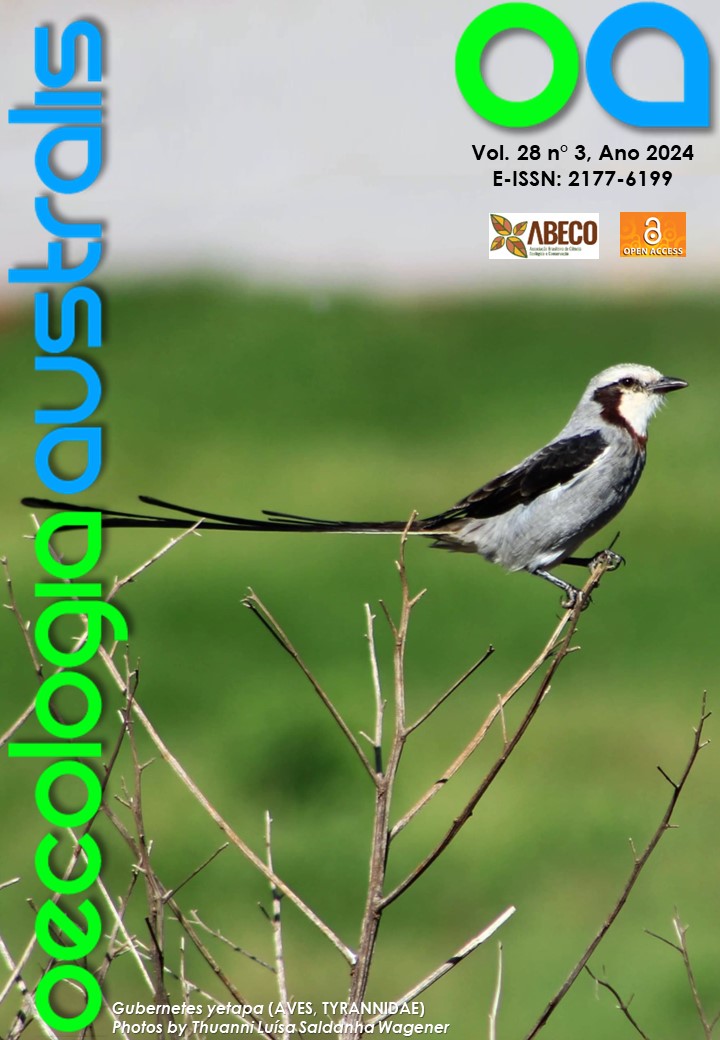O (DES)CONHECIMENTO DA BIODIVERSIDADE: UMA SISTEMATIZAÇÃO SOBRE LACUNAS, LIMITAÇÕES, VIESES, DÉFICITS E RUÍDOS
O (des)conhecimento da biodiversidade
DOI:
https://doi.org/10.4257/oeco.2024.2803.01Abstract
A partir dos avanços das ferramentas de bioinformática e ecoinformática tornou-se viável usar grandes quantidades de informação sobre biodiversidade para descrever padrões biológicos e tentar avaliar os processos ecológicos e evolutivos subjacentes a eles, bem como estabelecer ações mais efetivas e abrangentes para conservá-la. Contudo, as informações existentes acerca da biodiversidade ainda são incompletas, possuindo lacunas, limitações, vieses, déficits e ruídos. Neste sentido, reconhecemos a necessidade de discutir problemáticas relacionadas ao uso dos grandes bancos de dados de biodiversidade e a sua qualidade, discussões estas que precisam ser conceitualizadas de forma mais estruturada. Neste texto, iremos descrever de forma sistematizada as lacunas, limitações, e vieses do conhecimento da biodiversidade, problemas que estão diretamente associados à obtenção de informações das espécies na natureza. Em seguida, delimitaremos os tipos de déficits e ruídos, que são problemas associados aos bancos de dados da biodiversidade. Isso se deve ao fato de que as informações presentes nos registros primários e nos grandes bancos de dados frequentemente são usadas de forma inadequada. Além disso, apontamos também perspectivas sobre como abordar essas deficiências em trabalhos ecológicos/biogeográficos, por meio de uma adequada curadoria dos bancos de dados e da construção de mapas de ignorância. Por fim, destacamos desafios futuros, como a necessidade de novas coletas de dados, a formação de novos taxonomistas e o fornecimento de subsídios financeiros para a infraestrutura e a digitalização das coleções biológicas.
BIODIVERSITY (UN)KNOWLEDGE: A SYSTEMATIZATION OF GAPS, LIMITATIONS, DEFICITS, BIASES, AND NOISE
With the advancements in bioinformatics and ecoinformatics tools, it has become feasible to utilize vast amounts of biodiversity information to describe biological patterns and attempt to assess the ecological and evolutionary processes underlying them, as well as to establish more effective and comprehensive conservation actions. However, existing information regarding biodiversity remains incomplete, with gaps, limitations, biases, deficits, and noise. In this regard, we acknowledge the need to discuss issues related to the use of large biodiversity databases and their quality, discussions that need to be conceptually structured. In this text, we will systematically describe the gaps, limitations, and biases in biodiversity knowledge, issues that are directly associated with the acquisition of species information in nature. Subsequently, we will outline the types of deficits and noise, which are problems associated with biodiversity databases. This is because the information present in primary records and large databases is frequently used inadequately. Additionally, we also point out perspectives on how to address these deficiencies in ecological/biogeographical work through appropriate database curation and the construction of maps of ignorance. Finally, we highlight future challenges, such as the need for new data collections, the training of new taxonomists, and the provision of financial support for the infrastructure and digitization of biological collections.


